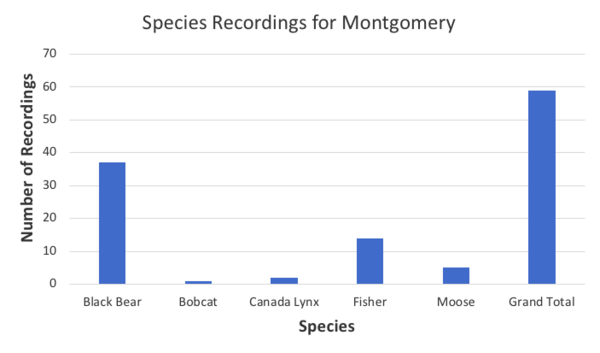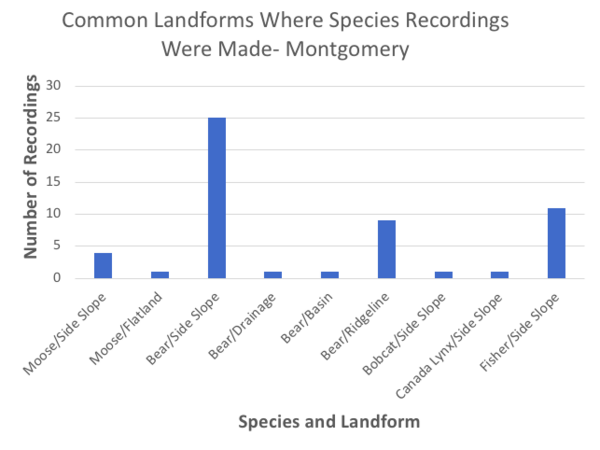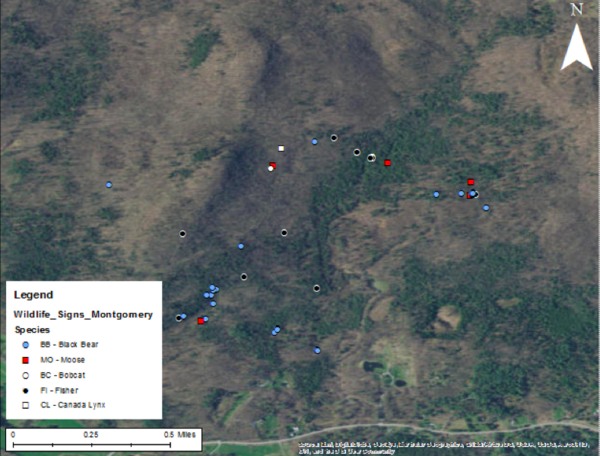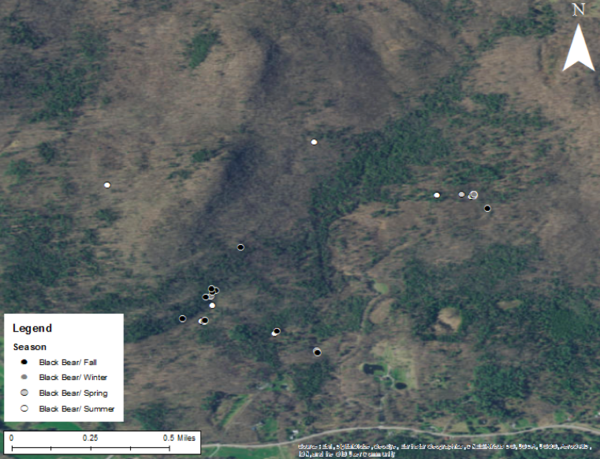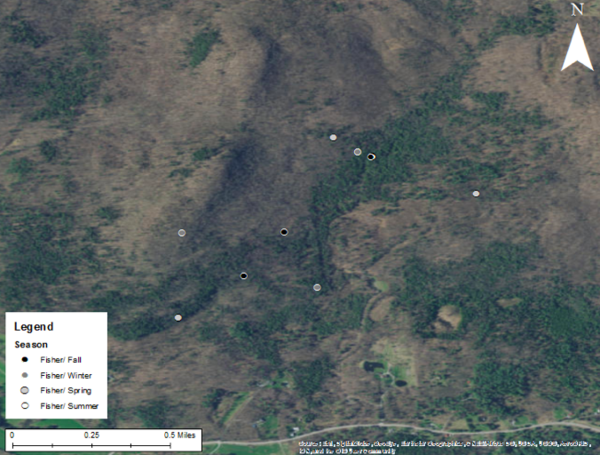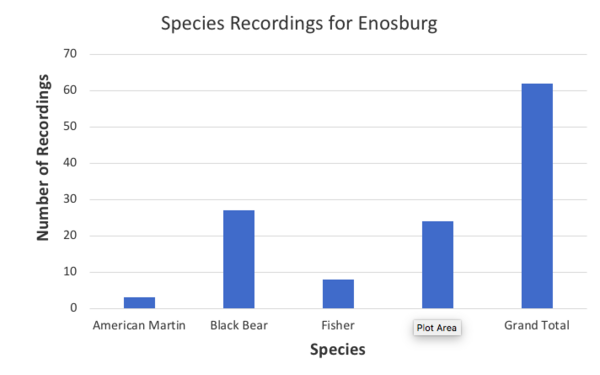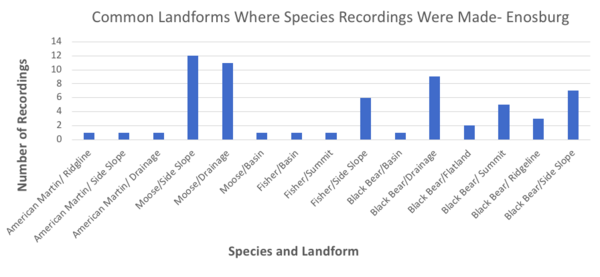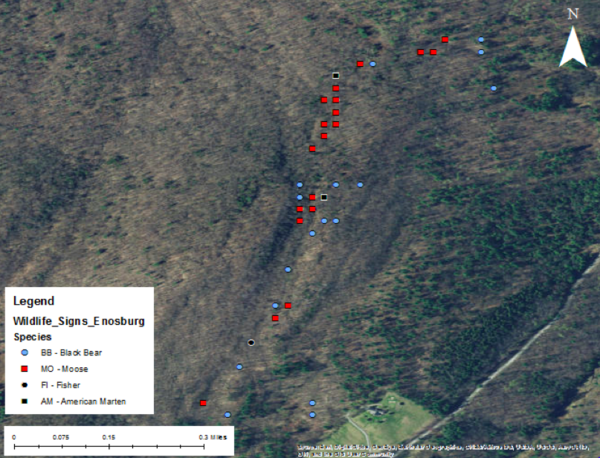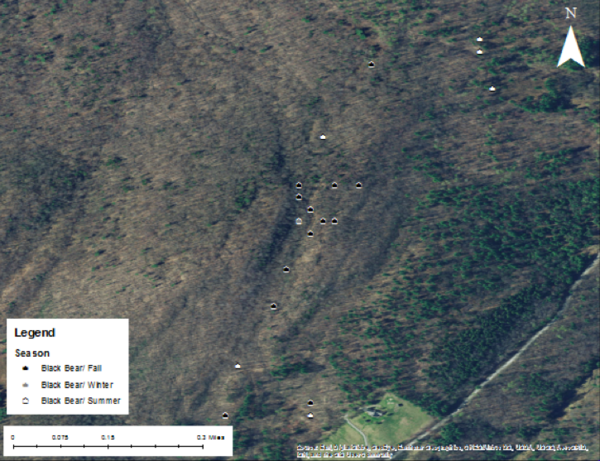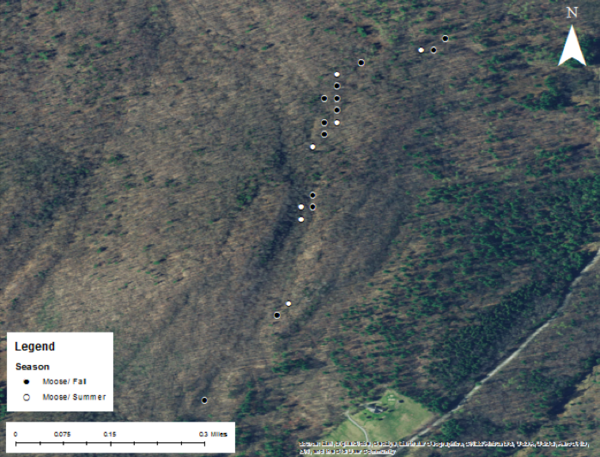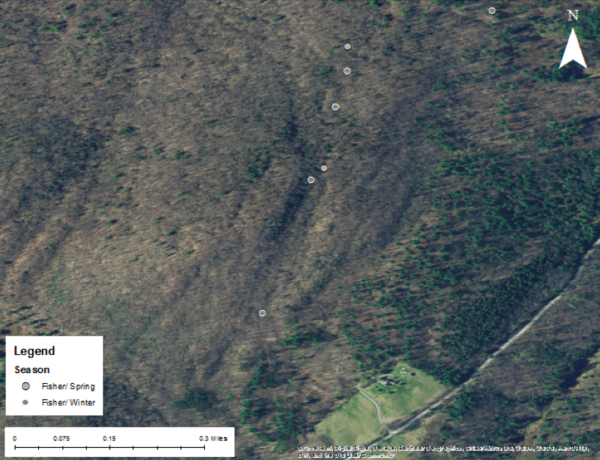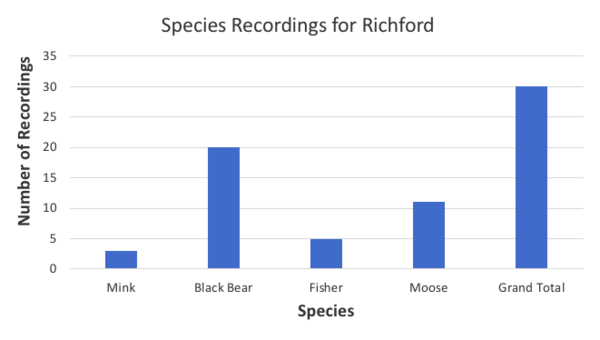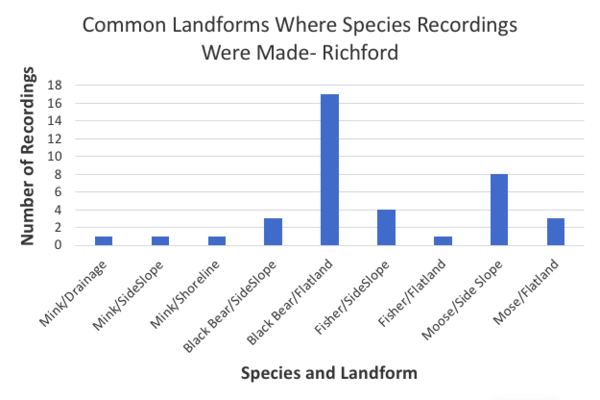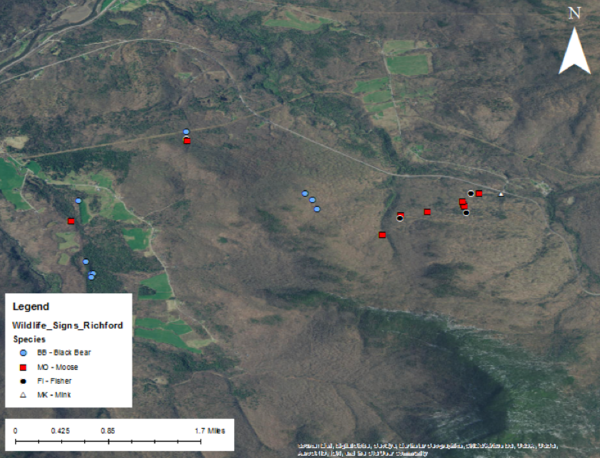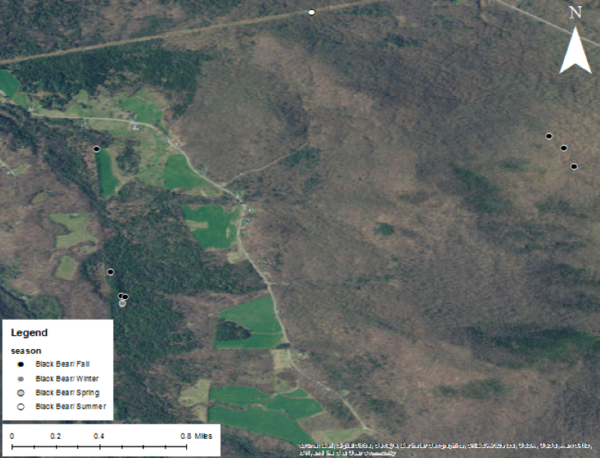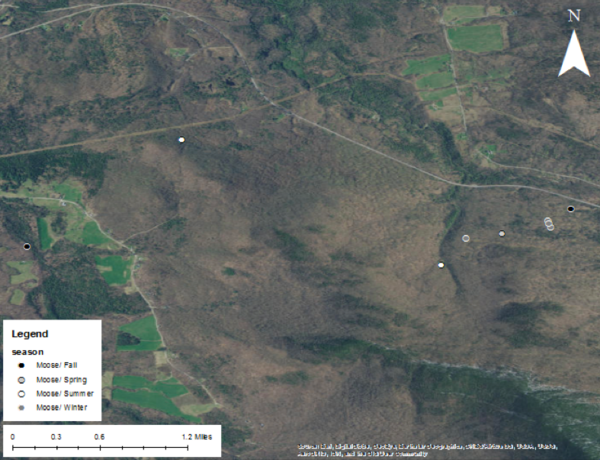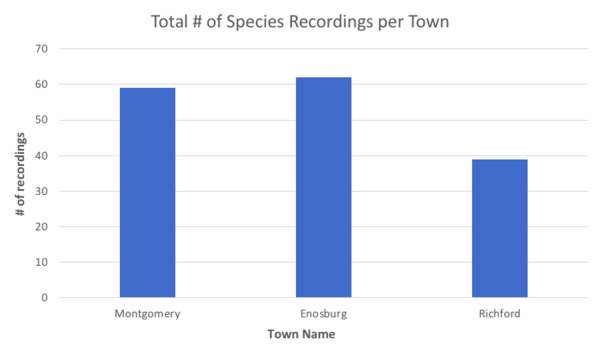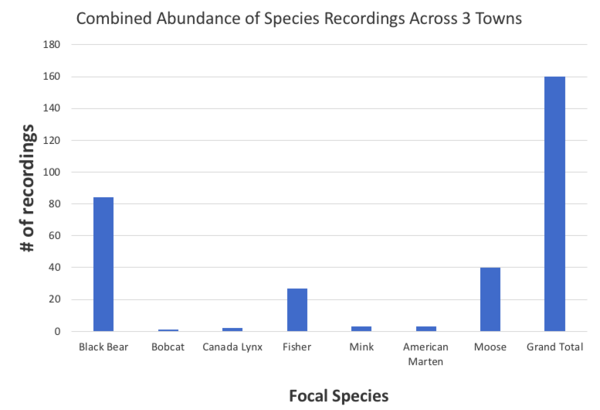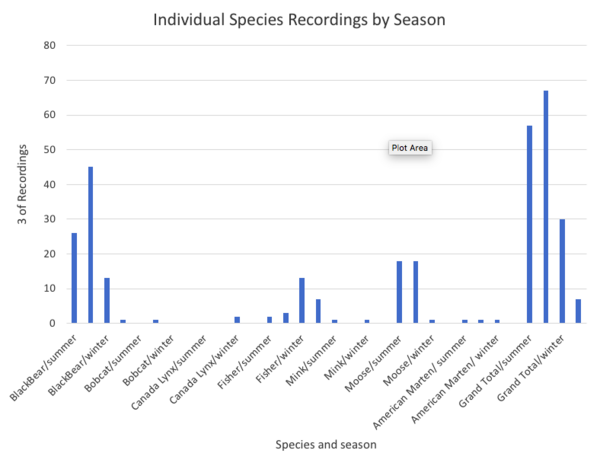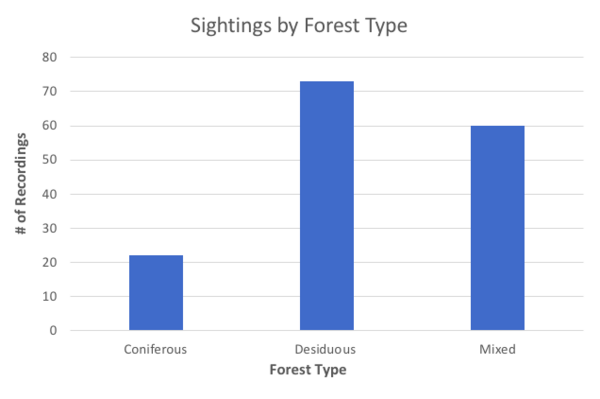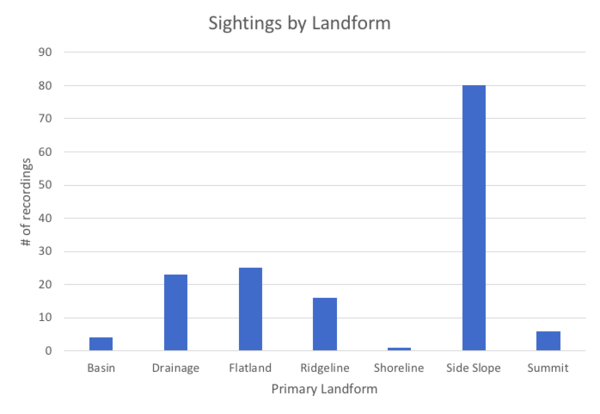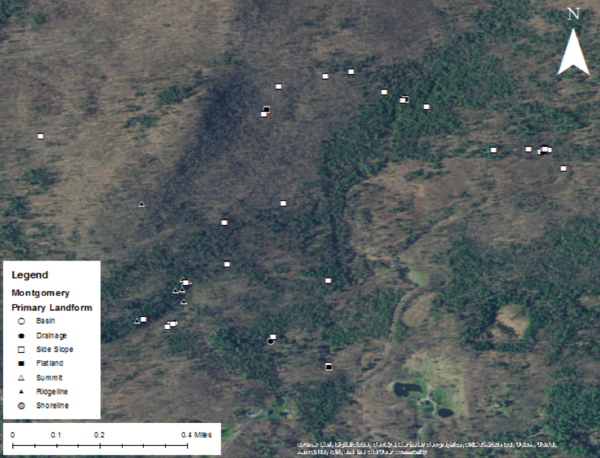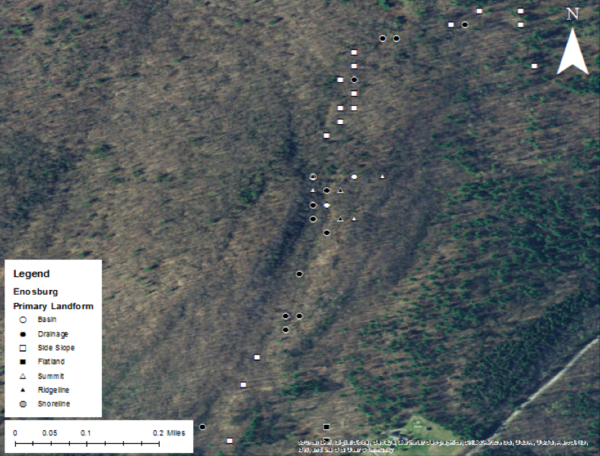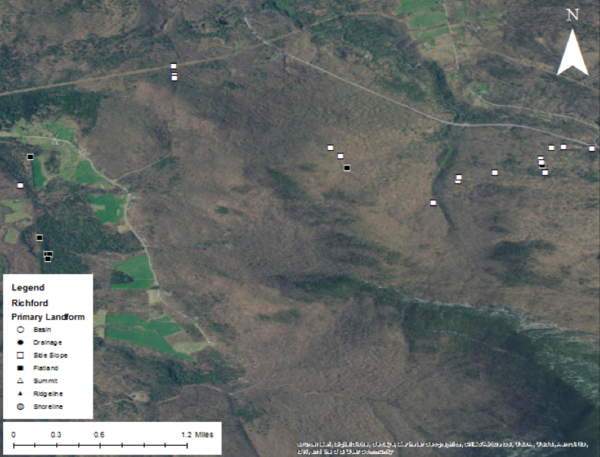During his time as the AmeriCorps member for the Forest Ecosystem Monitoring Cooperative, Jake Van Deursen generously donated his time to analyze five years of data from Cold Hollow to Canada's Keeping Track Monitoring Program. The Keeping Track Monitoring Program is comprised of dedicated citizen scientists who monitor and record tracks and sign of resident populations of wide-ranging mammals in the Cold Hollow region. This 5-year analysis from 2016 to 2019 is the culmination of 10 years of monitoring and the second Keeping Track Monitoring Program report. Cold Hollow to Canada is grateful for the continued dedication of our citizen scientists and for Jake's time in putting together this report.
Wildlife signs used to compile the species recordings in the following study, consist of animal tracks, feeding signs, tree markings, hair and scat. Because most species recordings are based off wildlife signs and not wildlife sightings, species abundance and movement cannot be determined from these records. Even though wildlife signs do indicate species presence, the number of individual specimens responsible for these signs cannot be determined. Since an individual specimen’s location cannot be tracked throughout a transect, species movement patterns cannot be inferred from these records. The recordings of wildlife signs from different transects in the towns of Montgomery, Enosburg and Richford can show presence, absence and distribution potential for key focal species. The following data analysis can be used to provide information for towns based on the species found in their transects, and therefore educate decisions surrounding future land use.
MONTGOMERY
In Montgomery, species recordings from 2016-2019 primarily consisted of black bear signs (Graph 1). There were 37 recordings of black bear signs throughout this transect, while 14 signs of fishers were reported. Moose, Canada lynx and bobcat signs were found to be less abundant than black bears and fishers. Moose tallies reached 5, while Canada lynx reported 2 sightings and bobcats reported 1.
By separating an area into common landforms, terrain can be better understood through variations in soil and vegetation that distinguish wildlife habitat. In order to achieve a more thorough depiction of a towns landscape, the primary common landforms were documented where each species sign was recorded (Graph 2). Landforms existing in the Montgomery transect include side slopes, flatlands, drainages, basins, and ridgelines. For each species in Montgomery, the majority of recorded signs occurred on side slopes. This accounts for 25 black bear, 11 fisher, 4 moose, 1 bobcat and 1 Canada lynx. However, there were 9 black bear signs recorded on ridgelines, 1 black bear sign recorded in a basin and a drainage, and 1 moose sign and one bear sign recorded for flatland.
Spatial Analysis for Montgomery:
Species Presence in Montgomery
There were high numbers of black bear and fisher signs in Montgomery, as well as scattered evidence for moose and few signs of bobcat and Canada lynx (Figure 1). Black bear signs occurred in a dispersed orientation with a large cluster to the northern side of the distribution. Fisher signs were evident in across the distribution with clusters to the southern side of the transect.
Seasonal Analysis for Montgomery:
Seasonal Black Bear Presence in Montgomery
There were black bear sightings in all four seasons in Montgomery, however, the majority of signs were found in the fall reporting 16 signs and in the summer reporting 11 signs (Figure 2). There were only 9 black bear signs found in the winter and 1 found in the spring. These observations most likely reflect black bear behavior patterns, indicating higher activity levels in the fall and spring are not surprising before partial dormancy in the winter months.
Seasonal Fisher Presence in Montgomery
Fisher sightings occurred in all four seasons with 5 signs evident in the winter, 5 signs in the spring, 3 in the fall and one in the summer (Figure 3). Winter and spring fisher signs were also more apparent in older reports.
Temporal Comparison for Montgomery:
Based off of an earlier report on Trends in Abundance and Seasonality in Montgomery, black bear signs increased, and moose signs decreased substantially in the 2016-2019 report. Black bear signs went from 26 to 37, and moose signs went from 22 to 5. Fisher signs decreased from 16 to 14. Bobcat and Canada lynx signs were seldomly seen in both reports, and while reported bobcat signs decreased from 2 to 1, there were 2 lynx signs documented in both reports. All species signs recorded in the earlier report were accounted for the recent report, except there was no evidence of mink in the recent report as compared to the 1 mink sign documented in earlier report. Total species recordings decreased from 70 in the earlier report to 59 in the recent report.
When comparing the two reports, there were few differences in the landforms where the signs occurred. Wildlife signs in Montgomery were predominantly seen on side slopes for all species except for the Canada lynx, whose activity shifted from ridgelines to side slopes in the more recent report. A substantial amount of black bear signs were found on ridgelines in both reports. The moose signs not occurring on side slopes in the more recent report were recorded on flatlands differing from the signs seen in drainages in the earlier report. Drainages held a portion of recorded wildlife signs in both reports.
ENOSBURG
For the Enosburg transect there were far more recordings for black bears and moose then for American martins and fishers (Graph 3). 27 black bear signs and 24 moose signs were recorded, while only 8 fisher and 3 American martin signs were documented. This could be due to behavioral differences between the species, such as the fact that fishers and American martins are secretive and solitary animals.
When broken up into distinct landforms, a landscape can provide more context for examining an area in terms of wildlife habitat (Graph 4). In Enosburg, wildlife signs were seen in the following landforms; ridgelines, side slopes, basins, drainages, summits, and flatlands. The majority of signs were found to be present in drainages and on side slopes. There were 12 moose signs, 7 black bear signs, 6 fisher signs, and 1 American martin sign found on side slopes and 11 moose sings, 9 black bear signs and 1 American martin sign found for drainages. Other than these recordings, there was 1 American martin sign and 3 black bear signs found on ridgelines, 1 moose sign, 1 fisher sign and 1 black bear sign found in a basin, and 1 fisher sign and 1 black bear sign found at a summit. There were black bear signs documented at all of the recorded landform types in Enosburg.
Spatial Analysis for Enosburg:
Species Presence in Enosburg
There were predominantly black bear and moose signs dispersed evenly north to south throughout the Enosburg transect with far fewer signs of fishers and the American marten (Figure 4). Although dispersed, more black bear recordings were found in the central aspect of the transect and more moose signs were found in the central northern part of the transect.
Seasonal Analysis for Enosburg:
Seasonal Black Bear Presence in Enosburg
Black bear signs were recorded in the fall, winter and summer in Enosburg, with the majority of evidence found in the fall (Figure 5). There were 18 signs found in the fall, 7 found in the summer and 2 found in the winter.
Seasonal Moose Presence in Enosburg
Moose recording in Enosburg were only found in the fall and summer months, with the majority of signs found in the fall and the minority found in the summer (Figure 6). There were 15 moose signs found in the fall and 9 found in the summer which can be difficult to infer from figure 6 due to the close proximity of sign recordings.
Seasonal Fisher Presence in Enosburg
Fisher signs were apparent in the spring and winter in Enosburg (Figure 7). The majority of signs, 6, were found in the winter, while 2 were found in the spring. Fisher signs were found primarily in the winter and spring for all towns as well as in past reports, indicating either that snow plays a role in the recognition of fisher tracks or that fishers have higher activity levels during these months.
Temporal Comparison for Enosburg:
For the earlier report on Trends in Abundance and Seasonality in Enosburg, black bear signs were the most frequently documented just as in the 2016-2019 report. In the recent report, moose signs were still the second most common recorded wildlife signs. When comparing the two reports, wildlife sign recordings increased for all species except for the American martin, bobcat and Canada lynx. Although bobcat and Canada lynx signs were seldom seen in the earlier report (only 1 sign recorded for each), there were no signs recorded in the recent report. There were 3 American martin signs recorded in each report. Fisher signs increased from 1 in the earlier report, to 8 signs recorded in the recent report. Black bear signs increased from 22 to 27 and moose signs increased from 9 to 24.
Between the two reports, primary landforms where wildlife signs were documented shifted for most species. Moose signs occurred slightly more often in drainages in the earlier report, but by a narrow margin, were more often seen on side slopes in the recent report. Black bear signs occurred substantially more often on side slopes in the earlier report but were seen the most frequently in drainages in the 2016-2019 report. Black bear signs were also seen on ridgelines and flatlands in both reports but were found on summits and basins in only the recent report. For both reports, fisher signs were found on side slopes, but in the more recent report fisher signs were additionally present in basins, and on summits. American martin signs were seen on side slopes in both reports, however in the earlier report signs were present on shorelines that did not hold true in the recent report. American marten signs were recorded for drainages and basins in only the recent report.
RICHFORD
Species signs recorded in Richford primarily consisted of those exhibiting black bear activity (Graph 5). There were 20 signs of black bears, 11 moose, 1 fisher and 3 mink signs at this transect.
Wildlife signs in the town of Richford were found for the following landform types: flatland, shoreline, side slope, and drainage (Graph 6). The majority of species signs were found in the area’s flatland landform. All 16 of the documented black bear signs, 2 moose signs and the only fisher sign corresponded with flatlands terrain. The 2 mink signs came from drainage and shoreline landforms and 1 moose sign occurred on a side slope.
Spatial Analysis for Richford:
Species Presence in Richford
There were predominantly black bear and moose signs dispersed evenly west to east throughout the Richford transect with far fewer signs of fishers and minks (Figure 8). Although dispersed, there were more black bear recordings found to the western side of the transect and more moose signs found to the eastern side of the transect. Mink and fisher signs were located only on the eastern side of the transect.
Seasonal Analysis for Richford:
Seasonal Black Bear Presence in Richford
Black bear signs were found in the fall, winter and summer seasons in Richford (Figure 9). Although 11 signs were evidently found in the fall, there were 8 found in the summer. Only two black bear signs were found in the winter. The seasonal presence of black bear signs in Richford parallel the evidence found in past reports as well as in other towns. This evidence indicates higher activity levels for black bears in the fall and spring due to behavioral patterns. Some of these plots are not pictured in figure 9 due to an absence of coordinates for several observations.
Seasonal Moose Presence in Richford
Moose signs were found in all four months for Richford (Figure 10). Signs for moose occurred more frequently in the winter and summer months. There were 7 signs of moose in the summer, 4 in the winter, 3 in the fall and 1 in the spring. For other towns, the majority of moose signs also occurred in the summer most likely indicating higher levels of activity leading into breeding season. Some of these plots are not pictured in figure 9 due to an absence of coordinates for several observations.
Temporal Comparison for Richford:
In comparison to a previous report from Richford, there were less wildlife signs in total for all recordings. In past years bobcats have been present at this transect but in the most recent report there were no signs found. Mink signs found the 2016-2019 report were not found in past years. Historically, signs of bobcats, fishers and minks have been less frequent then signs of larger animals such as black bears and moose and this holds true to more recent data. In relation to other animals, black bear signs were still the most common in this transect followed by Moose signs. The amount of Moose signs recorded decreased by more than half (from 11 to 3) in comparison to the older report.
As side slopes showed the most activity historically in Richford, recent data shows most wildlife signs occurring in flatland landforms. In the earlier report black bear, moose, and fisher signs were most commonly found on side slopes but in the recent report, all black bear signs, 2 out of 3 moose signs, and the only fisher sign were found on flatlands.
Conclusions and Conservation Implications
When considering implications for the interpretation of this report, it is important to consider that the types of tracks used to compile recordings may differ for each species. Black bear signs consisted of scat, tacks, tree marks and hair, while the presence of moose consisted of their tracks and feeding signs. Evidence of an American marten was determined by scat, tree marks and hair, while minks and fishers were represented by scat, hair, urine and tracks. The presence of bobcats and canada lynx were solely indicated by tracks. The difference in number of sign recordings for some species could relate to the variety of animal signs used identify the presence of a particular species. It is possible that patterns in animal behavior and the persistence of certain animal signs could lead to a greater abundance of recordings based off the type of documented sign. Tracks and tree markings could be the most frequently documented animal signs based on their abundance and the longevity of their presence in mixed environments. Tracks and tree markings may also be easier to spot or identify in general when compared to scat, urine and hair.
When looking at the total number of recordings across three towns, Enosburg had the highest with a count of 62, while Montgomery had 59 and Richford had 39 (Graph 7). When compared to an earlier report, Trends in Abundance and Seasonality in Enosburg, Enosburg and Richford both saw more recordings of wildlife signs while Montgomery had fewer. In the earlier report Enosburg had 37 recordings and Richford had 30, showing an increase in 25 and 9 in recent years. Montgomery recordings were 70 in the earlier report, as compared to 59 in the 2016-2019 report, showing a decrease of 11.
Across the three towns black bears made up the majority of wildlife signs, accounting for 84 species recordings (Graph 8). Moose followed with 70 recordings, while fishers had 27, mink 3, American Marten 3, Canada lynx 2, and bobcats 1. When looking at towns individually, all three towns had a majority of black bear recordings while moose recordings were the second most frequent in Richford and Enosburg. For the most part this trend holds true across the three towns although Fisher signs were the second most frequent recordings in Montgomery. However, in an earlier report, moose were the second most frequently recorded species signs in Montgomery.
In all three towns, a transect walk was conducted in every season in hope to develop a better understanding of when it may be more common to find wildlife signs from certain species in the Cold Hollow Mountains. The seasonal component of this report provides more evidence for deciding whether a species is resident or transient in the region (Graph 9). Transient species do not inhabit an area year-round, but evidence of animals from these transect walks may prove that this habitat provides temporary support for wildlife as it travels or disperses to other areas. Black bears, fishers and moose have been tracked in all four seasons, while American marten signs were found in the fall, summer and winter and mink signs were found in the summer and winter. Bobcat signs were found only in the fall and Canada lynx signs were found only in the winter. It is likely that the recordings from the more frequently seen species such as black bear, moose and fisher, can provide an accurate depiction of their seasonal residence. For the species with lesser recorded signs, like the American marten, mink, bobcat and Canada lynx, it is too difficult to accurately depict whether a species is transient or resident.
Most of the species recordings gathered from these transect walks were taken from forested landscapes, primarily deciduous. Because forest types shift based on elevation, this information can indicate that deciduous and mixed forests contain the majority of focal wildlife in Vermont. Although this may be true, it is also important to note that the transects in this study are most likely made up of primarily deciduous and mixed forest cover.
Based off of species recordings, side slopes accounted for the most wildlife signs by a substantial margin. Because side slopes contained the vast majority of wildlife sign recordings for the three towns combined, it is likely that focal species are primarily using side slopes as lanes of travel. Side slopes, being the transitional aspect from a flatland/basin/drainage to a summit or ridgeline, can not only provide valuable attributes for wildlife passage, they can provide attractive features that supplement animal behavior such as feeding and isolation.
Based on the dispersed and scattered distribution of wildlife signs according their primary landform in Montgomery, it can be seen that most signs were found on side slopes. Side slopes were the most frequent host for wildlife signs cumulatively for all the three towns. A cluster of ridgeline plots can be seen to the eastern aspect of this transects as well as flatland and drainage points scattered all around but less frequently. Similarly, in the older report, ridgelines were also the second most prominent landform behind side slopes. This shows little change over time in regard to primary landforms in Montgomery.
The majority of wildlife signs in Enosburg were found on side slopes as seen in figure 12, spanning from north to south. Enosburg also contained a reasonable proportion of the signs found in drainages, and accounted for more drainage recordings then the other two towns. Enosburg recordings brought total drainage recordings up for the primary landform comparison across all three towns. As seen in the topography of figure 12, there were also a handful of summit and ridgeline recordings found where these landforms were prominent, clustered in the center of the transect. When reviewing the earlier report, side slopes and drainages were also the most frequent and second most frequent recorded landform. This shows little change in landforms for Enosburg occurring over the past decade.
For Richford, the majority of signs were recorded on flatlands which does not resemble the overall trend seen from all three towns. The varying frequency of signs found on certain primary landforms can be due to the prominence of that landform in the given town. For instance, it could be that the transect walked in Richford was made up primarily of flatland, therefore the species signs would have greater odds of being observed on this landform. In comparison to an earlier report, side slopes were the most prominent landform in Richford, indicating that the spike in flatland recordings for the recent report differs from the general trend. This could indicate a change in Richford’s primary landforms in the last five years, or reflect differences in the route of the new transect. The latitudinal and longitudinal spread of the side slope landform points seen in Figures 11, 12 and 13 may indicate that side slopes actually occur more often in Vermont forests.
From the focal species recordings documented in the previous Keeping Track Program reports, wildlife presence, absence and distribution can be better understood on both a spatial and temporal scale. By reviewing these sign recordings based on species, location, landform, season, and forest type, valuable evidence can be gathered pointing to where species are and when they are there. When applying this program across towns, the connectivity of this data can provide for widespread knowledge on the distribution of focal species and their basic movement patterns. With the knowledge derived from year to year comparisons, it is possible to see not only changes in species behavior but changes in a species habitat as well.
Evidence of such changes provided by the records of focal species signs, can provide land managers and town spokespersons will essential insight for decisions surrounding future land use. The continuation of this report will be necessary to draw further conclusions on wildlife whereabouts and presence, in order to prevent drivers of habitat fragmentation and destruction in Vermont’s Cold Hollow Mountains.
A copy of the 2016-2019 Keeping Track report and the previous report are available for download on our Keeping Track page.
